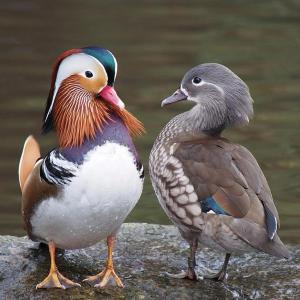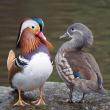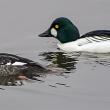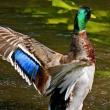Kristen Lindquist: The season when ducks choose their mates
 WoodDuckpr-JonSailer: Pairs of Wood Ducks (left) will soon start visiting waterside trees together to find the perfect nest hole. Photo by Jon Sailer/Wikimedia.
WoodDuckpr-JonSailer: Pairs of Wood Ducks (left) will soon start visiting waterside trees together to find the perfect nest hole. Photo by Jon Sailer/Wikimedia.
 Long a symbol of fidelity, wild Mandarin Ducks only stay faithful for a season. Photo by Francis C. Franklin/Wikimedia.
Long a symbol of fidelity, wild Mandarin Ducks only stay faithful for a season. Photo by Francis C. Franklin/Wikimedia.
 Look for displaying Common Goldeneyes just offshore or on open lakes and rivers. Photo in Public Domain.
Look for displaying Common Goldeneyes just offshore or on open lakes and rivers. Photo in Public Domain.
 A Mallard drake flashes his patch of blue secondary feathers, known as a speculum. Photo by Rror/Wikimedia.
A Mallard drake flashes his patch of blue secondary feathers, known as a speculum. Photo by Rror/Wikimedia.
 WoodDuckpr-JonSailer: Pairs of Wood Ducks (left) will soon start visiting waterside trees together to find the perfect nest hole. Photo by Jon Sailer/Wikimedia.
WoodDuckpr-JonSailer: Pairs of Wood Ducks (left) will soon start visiting waterside trees together to find the perfect nest hole. Photo by Jon Sailer/Wikimedia.
 Long a symbol of fidelity, wild Mandarin Ducks only stay faithful for a season. Photo by Francis C. Franklin/Wikimedia.
Long a symbol of fidelity, wild Mandarin Ducks only stay faithful for a season. Photo by Francis C. Franklin/Wikimedia.
 Look for displaying Common Goldeneyes just offshore or on open lakes and rivers. Photo in Public Domain.
Look for displaying Common Goldeneyes just offshore or on open lakes and rivers. Photo in Public Domain.
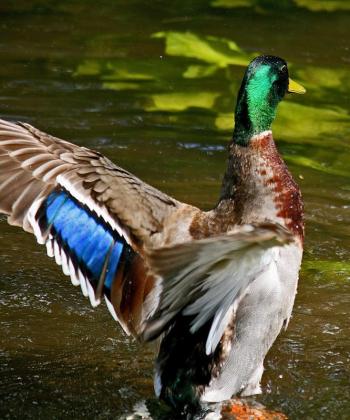 A Mallard drake flashes his patch of blue secondary feathers, known as a speculum. Photo by Rror/Wikimedia.
A Mallard drake flashes his patch of blue secondary feathers, known as a speculum. Photo by Rror/Wikimedia.
In his long poem “The Parlement of Foules,” Elizabethan era poet Geoffrey Chaucer shared the belief that birds choose their mates on St. Valentine’s Day. For waterfowl, this is not simply a poetic premise. Many ducks wintering here in Maine are beginning to pair off and form partnerships now for the breeding season ahead. In a month or two these pairs will migrate north together. And because they’ve already found one another and courted, they won’t need to waste time on the duck equivalent of dating apps and bar scenes. They can get right down to business and mate as soon as they get to their breeding grounds.
Unlike geese and swans, which mate for life, most ducks are only seasonally monogamous, forming new partnerships each year that last only a few months—a bit like an episode of one of those matchmaking shows on TV. Sometimes the drake doesn’t even stick around to see the eggs hatch. The beautiful Mandarin Duck, an East Asian species related to our Wood Duck, has long been considered a symbol of fidelity in its native China. Pairs would be given as wedding gifts. But even these supposed paragons of lifelong faithfulness find new mates each spring.
We can readily watch an avian version of “The Bachelor” right here on our own waterfront. Along open stretches of the Megunticook River and in Camden Harbor in recent weeks, I’ve been seeing small groups of Mallards gather daily to feed and fool around.
In the water the ducks repeatedly bob their heads at one another, grooving to their own beat, as if saying, “Yes, yes, I like what I see here.” Or sometimes several males at once will tip their butts up and pull in their wings to show off their flashy blue secondary feathers, the kind of posturing any teenager might recognize. Both sexes also swim around each other with their heads outstretched along the water, which apparently indicates interest.
Red-breasted Mergansers that are in the mood will dip their feather-spiked heads as if bowing courteously to one another. Common Eider drakes have also adopted a head bob move, along with a special cooing sound, that they use on the ladies.
Striking black and white Common Goldeneye drakes perform dramatic head dances for the females they’re trying to impress. The male flings his head back in an exaggerated way, almost to his back and then straight forward, over and over. He also does a head throw combined with kicking his feet back in the water. The behavior is noticeable to us because it’s so strange looking. However, as is often the case with courtship, it’s not always clear that the hen ducks are paying much attention.
During courtship season, energized and made more aggressive by hormones, male ducks also spend a lot of time chasing each other away from the females. These same hormones also play a part in enlarging their genitals each spring. Unlike almost all other birds, male waterfowl are unusual in that they possess penises. Each breeding season, these organs grow anew in size. Duck penises, which are corkscrew-shaped, can be quite long compared to body size.
Of note, the Lake Duck from southern South America has the longest penis compared to body length of any vertebrate. An individual Lake Duck collected in Argentina had a 16.7-inch penis, as long as his own body: the Guinness World Record for avian penises. Even more interesting, a recent study seems to indicate that Lesser Scaup drakes will grow longer penises in some years in response to the presence of more rivals for the females’ attention. Among ducks at least, size matters.
Courtship displays aside, duck sex isn’t always a pretty thing. Male ducks that don’t get lucky and find their own mate to fly north with will often copulate with any female they can catch. This explains, in part, the unusual length of their reproductive organs. In a fascinating evolutionary twist, however, duck vaginas have evolved a complex shape to help counteract forced mating. The business of reproduction is a clearly a complicated one, even for species other than our own.
And no less intriguing. For their first date, a bird biologist friend of mine took his now-wife to watch male prairie chickens perform their group courtship display. The Maine version of that might involve a romantic visit together to an (unfrozen) local harbor to watch the sea ducks bobbing and weaving as avidly as kids on a dance floor. Each bird is desperately looking for its one true love, the one with whom they will fly away side by side for miles and start a family—if just for a few brief months...
Kristen Lindquist is an amateur naturalist and published poet who lives in her hometown of Camden.

Event Date
Address
United States


